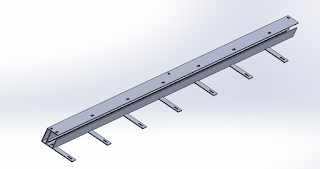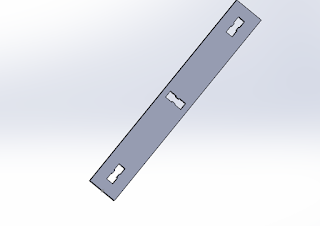Friday, July 1, 2016
Week Achievements
During the past week, the Solar Group has accomplished the following tasks:
Sub-team of Design and Manufacturing:
-Maximizer customization;
-Base and track connection development;
Sub-team of Power System Design:
-Electric Parameters Definition (70%);
-Panels, Inverters and batteries setup definition (80%);
Additional tasks:
- Sponsors/Manufacturers database creation (15%);
Design and Manufacturing Sub-team deliverables:
Power System Design Sub-team deliverables:
Sub-team of Design and Manufacturing:
-Maximizer customization;
-Base and track connection development;
Sub-team of Power System Design:
-Electric Parameters Definition (70%);
-Panels, Inverters and batteries setup definition (80%);
Additional tasks:
- Sponsors/Manufacturers database creation (15%);
Design and Manufacturing Sub-team deliverables:
This week I was working on the racking system for the solar panels. I designed a track like the picture below. The track on the left is designed to be installed on a different area than the one on the right.
There are two track for the solar panels rack. One of the tracks will be on the far right or far left of the rail and the other track will be connected to the support beams that hold up the rails. I designed one track to utilize the ribs on top of the railing as support and the other one to utilize the support beams. Each track will use the same “CAM LOCK” mechanism that is essentially a 90 degree lock and opening mechanism As Shown Below. On the track connecting the support beams; there will be three of these Cam Lock that connect to a support plate on each of the support beam .
For the support best track, there will be a connecting mechanism that slides inside of each support beams, and becomes drilled into the support beam. The connecting mechanism allows the cam lock to tighten the support beam plate as shown below.
I am now working on a gearing mechanism that allows a robot to turn the central Cam lock on the support plate and results in turning the two exterior cam locks; reason for this is to make labor close to non.
Power System Design Sub-team deliverables:
Section 1 (440/450 mˆ2)
Inverter: Power-One, Inc.: PVI-10.0-I-OUTDx-US-480-y-z 480V
Solar Panel: SunEdison MEMC-F270KzC-2y
Annual Energy: 59,074 kWh
DC to AC ratio is 1.42
Modules per string: 11
Strings in parallel: 11
Number of inverters: 3
Section 2 (225/245 mˆ2)
Inverter: Power-One, Inc.: PVI-10.0-I-OUTDx-US-480-y-z 480V
Solar Panel: MiaSolé Flex-02 350 W
Annual Energy: 40,261 kWh
DC to AC ratio is 1.42
Modules per string: 12
Strings in parallel: 9
Number of inverters: 2
Section 3 (360/408 mˆ2)
Inverter: Advanced Energy Industries AE_3TL_G3-12-6-08 48V
Solar Panel: SunEdison MEMC-F270KzC-2y
Annual Energy: 21,199 kWh
DC to AC ratio is 1.20
Friday, June 24, 2016
Current Progress Presentation
Attached is the second presentation of the Summer Interns of 2016. With a overall progress, the team presented their power estimation, tracking system cost analysis and the initial concepts designs of the solar panels mounting arrays.
Tuesday, June 21, 2016
Weekly proposals 06/20-06/24
Weekly Team Proposals Date: 06/20 – 06/24
Team Name: Solar
- Proposal Narrative (verbal description of what is proposed to be accomplished for the week, include design requirements and deliverables – aka deadlines)
- Improve the solar panel array design → 07/01
- Power estimation for the test track (number of batteries, panels and their disposition) → 06/24
- Search possible sponsors/manufacturers for the solar panel → 07/01
- Wayside pick up alternatives → 06/24
- Full scale test track parameters → 06/24
- Sketches / drawings / calculations (Attach presentations, Excel charts, data, Etc)
Solar Panel Array
Block Diagram
- Critical Path Schedule (scheduling project objectives for current week and future weeks, please include end goals)
The priorities for next week are going to be to start the improvement of the solar panel array design and to define the full scale test track parameters.
- Budget (look into Value-in-Kind – aka Sponsorships … and cash budget with Bill of Materials)
For now, the team is working only with designs, so there is no equipment needed. However, it would be helpful to have some snacks at the facility, as well as a better Internet connection.
Team Member 1: Durval
- Pertinent Skills: Solidworks, MS Office
- Responsibilities: Solar panel array design, search for sponsors/manufacturers
Team Member 2: Leonardo
- Pertinent Skills: SAM, MS Office
- Responsibilities: power estimation for the test track, Wayside pick up alternatives, Full scale test track parameters
Team Member 3: Eric
- Pertinent Skills: SAM, MS Office
- Responsibilities: power estimation for the test track, Wayside pick up alternatives, Full scale test track parameters
Team Member 4: Lucas
- Pertinent Skills: Solidworks, MS Office
- Responsibilities: Solar panel array design, search for sponsors/manufacturers
Friday, June 10, 2016
Week 2
Tasks accompished:
Shadow researchThis week, much progress has been made. The rough draft of the Paper on analyzing shadow-related power loss created, with major revision help from Ron Swenson and Professor Furman. The rough draft of paper submitted to the SOLAR 2016 conference
In addition, 3D modeling practice started. A lesson on Encitra was given by Carolina Nillson on monday night, and I have downloaded the necessary software
Power estimationIn the past three weeks, the sub team responsible for power estimation kept working on developing a tool capable of integrating the power consumption of the Full Scale Test Track and also the Full Scale City Routes with the software SAM - System Advisor Model, from the National Renewable Energy Laboratory. With this tool the team is able to predict and estimate how much area is going to be needed to fully supply these two different scenarios.All the analysis made was based on the textbook Transit Systems Network, by Professor Anderson from the University of Minnesota.The results from SAM includes the number of modules required, the total needed area and the annual energy available on the 2 different setups for the Full Scale models.SAM already includes losses from soiling and shading but in a near future the team will also incorporate an analysis from ENCITRA about shading conditions on the city of San Jose. This study will allow the best solar panels displacement along the track.
PV Module- Design concepts for new PV module developed(pictures below)
Shadow researchThis week, much progress has been made. The rough draft of the Paper on analyzing shadow-related power loss created, with major revision help from Ron Swenson and Professor Furman. The rough draft of paper submitted to the SOLAR 2016 conference
In addition, 3D modeling practice started. A lesson on Encitra was given by Carolina Nillson on monday night, and I have downloaded the necessary software
Power estimationIn the past three weeks, the sub team responsible for power estimation kept working on developing a tool capable of integrating the power consumption of the Full Scale Test Track and also the Full Scale City Routes with the software SAM - System Advisor Model, from the National Renewable Energy Laboratory. With this tool the team is able to predict and estimate how much area is going to be needed to fully supply these two different scenarios.All the analysis made was based on the textbook Transit Systems Network, by Professor Anderson from the University of Minnesota.The results from SAM includes the number of modules required, the total needed area and the annual energy available on the 2 different setups for the Full Scale models.SAM already includes losses from soiling and shading but in a near future the team will also incorporate an analysis from ENCITRA about shading conditions on the city of San Jose. This study will allow the best solar panels displacement along the track.
PV Module- Design concepts for new PV module developed(pictures below)
A block diagram for the power system
Subscribe to:
Comments (Atom)













